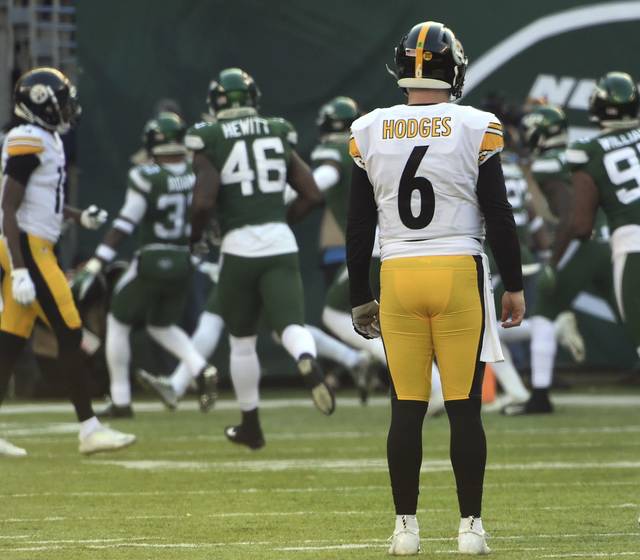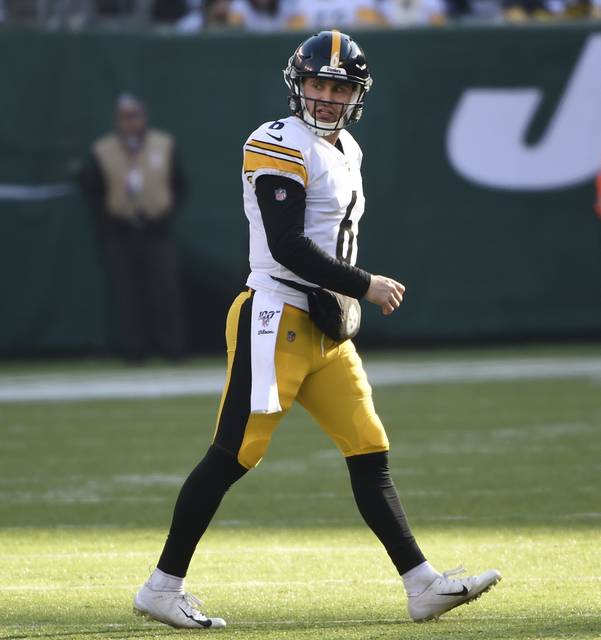John Steigerwald: The Devlin Hodges era is over for Steelers
The “Duck” Era is over.
If you still think Devlin Hodges has a future as the Pittsburgh Steelers’ quarterback, you haven’t been paying attention. Hodges had to be on a short leash after throwing four interceptions last week against the Buffalo Bills, but nobody should feel guilty about second guessing Mike Tomlin on his decision to start him instead of Mason Rudolph Sunday against the New York Jets.
Tomlin said Tuesday he thought Hodges deserved a chance to redeem himself and that was nice, but Hodges’ two interceptions to start Sunday’s game shouldn’t have been needed for Tomlin and his staff to realize Rudolph gave them the best chance to win.
Rudolph’s 29-yard touchdown pass to Diontae Johnson showed why he was drafted in the third round and why he was on the roster as Ben Roethlisberger’s backup.
It was a throw Hodges can’t make. Rudolph has an NFL arm. Hodges does not. Hodges showed that, in this dink and dunk era, a quarterback can succeed without a classic NFL arm as long as his defense is keeping it close and he’s not asked to do too much.
You know, like throwing the ball farther than 30 yards.
Falling behind 10-0 meant too much was going to be asked of Hodges.
Of course, as it turned out, the Steelers were depending on Hodges in the end because Rudolph left with a shoulder injury, and he made it clear again he’s a really nice story but probably not an NFL quarterback. If Hodges has to start in Baltimore next week, the Steelers are in big trouble. If they win with him against a makeshift Baltimore Ravens team or if the Tennessee Titans should lose to a makeshift Houston Texans team, it won’t be pretty in the playoffs if Hodges is the quarterback.
It won’t be worth making the trip.
Questionable choice of returner
During a season when the offense needs all the help it can get, how could Tomlin have gone so long with Ryan Switzer returning punts instead of Diontae Johnson? If you cast a ballot in the Coach of the Year voting, that might be something to keep in mind.
Johnson has shown he’s a guy who can break one at any time. Switzer looked like a guy who could break one about as often as there’s a total eclipse of the sun. You could probably go back through the Steelers’ early losses and find instances where a punt returned for a touchdown, or even one broken for a big gain, would have made a huge difference.
Passing fancy
Speaking of eras, we officially have reached the point where it’s ridiculous to compare quarterbacks from the modern era to the ones who played way back in the 20th Century.
It happened last Monday night when Drew Brees competed 29 of 30 against the Indianapolis Colts.
Come on.
Way back in 1978, the NFL decided to make rules changes because it had become way too hard for quarterbacks to complete passes, but when guys are throwing it 30 times in a game with one incomplete pass, the pendulum has swung way too far in the opposite direction.
Entering the second to last weekend of the season, there were four NFL quarterbacks who had completed 70% of their passes, led by Brees at 75.8
The NFL is getting a lot of play out of its list of the top 100 players in the first 100 years, and there will be current players such as Brees and Tom Brady and recent retiree Peyton Manning on the list, but no one should rank them based on their stats.
USA Today came out with it’s top 100, and Jerry Rice is No. 1, Brady is two. Rice has all the receiving numbers and there won’t be much pushback on him or Brady, but he’s no better than Paul Warfield, who didn’t make the list.
Warfield averaged 20.1 yards per catch playing for the Browns and Dolphins from 1964-77 when he could be knocked down anywhere on the field at any time before the ball was in the air. He averaged a ridiculous 25.1 yards per catch in 1970.
Rice, playing in the West Coast offense, made a living running 8-yard slants in an era when he couldn’t be touched more than 5 yards beyond the line of scrimmage.
He averaged 14.8.
That helped Joe Montana, who’s No. 6 on USA Today’s list.
In 1978, the first year after the rules changes, Terry Bradshaw averaged 18 yards per completion. That’s a long pass in 2019.
Brady and Brees have averaged 11.7. Brady’s best is 13.1, Brees’ is 12.4.
Lists are fun, but the numbers that get players placed on them require some context.
John Steigerwald is a Tribune-Review contributing writer.
Remove the ads from your TribLIVE reading experience but still support the journalists who create the content with TribLIVE Ad-Free.



